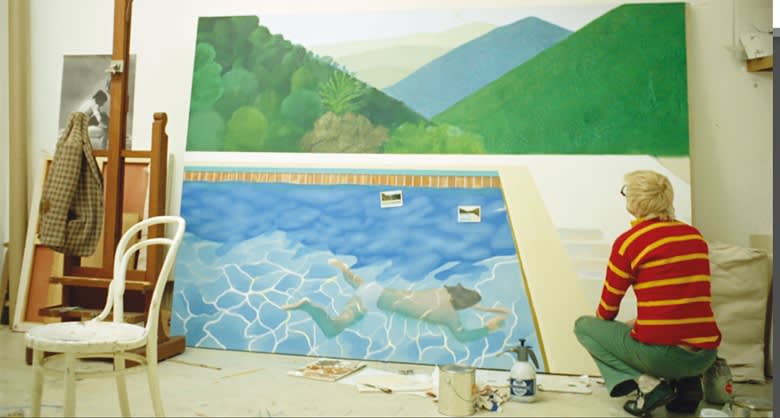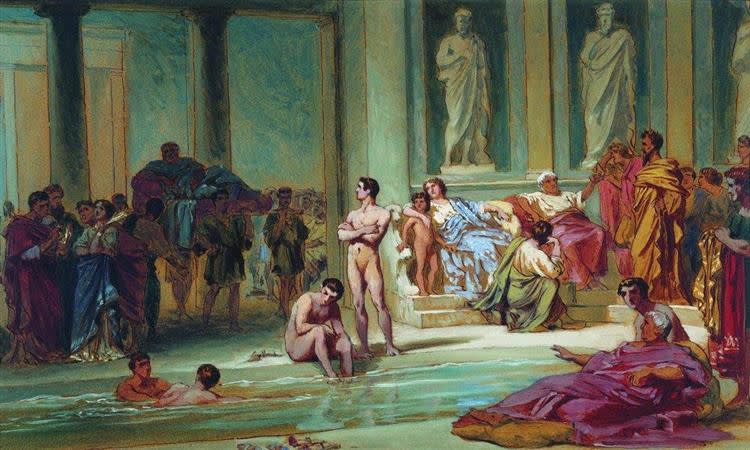
Fyodor Bronnikov
In The Roman Baths, 1865
A quintessential icon of summer, the swimming pool is so much more than it appears. Their designs can range from Roman bathhouses to biomorphic abstract shapes, while in America, the swimming pool represents the American Dream; a house with a lawn and swimming pool is seen as a portrayal of excellence and what one can achieve with hard work. This concept, amongst many others, is something countless artists have at one time explored.
The first name that probably comes to mind when one considers swimming pools in art is David Hockney. After visiting Los Angeles, Hockney became fascinated with the sheer quantity of houses with pools, which are a luxury in Britain. Entranced in California’s laid-back lifestyle, Hockney painted numerous swimming pools between 1964 and 1971, using these works as a means to explore painting water splashes. Hockney’s 1967 work, A Bigger Splash, features a modernist 1960s house. A strip of land separates the pool from the horizon, and a horizontal yellow diving board in the foreground establishes the piece’s perspective. Hockney’s pool paintings didn’t stop at the hypothetical though; in 1986 and 87 Hockney painted white arcs and squiggles on the walls and floor of the pools at Emmerich’s Top Gallant Farm in New York and the Roosevelt Hotel in LA.
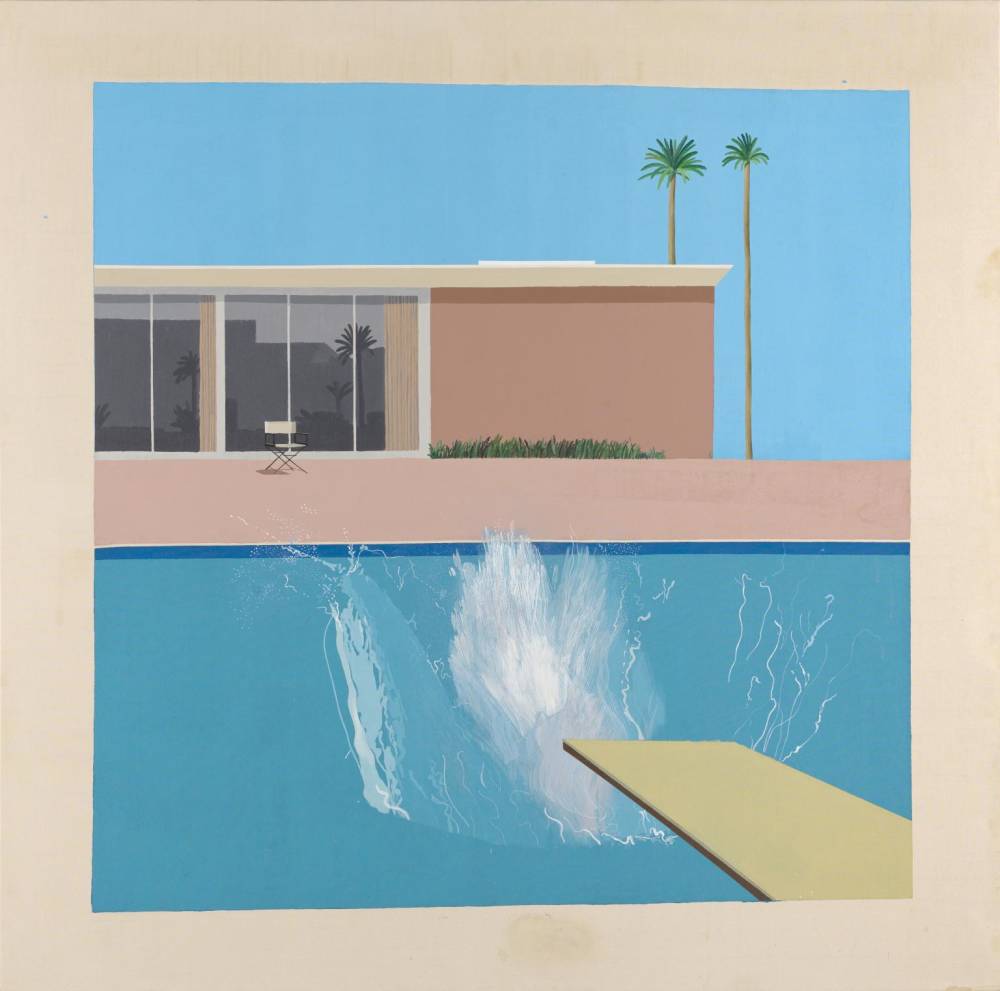
David Hockney
A Bigger Splash, 1967
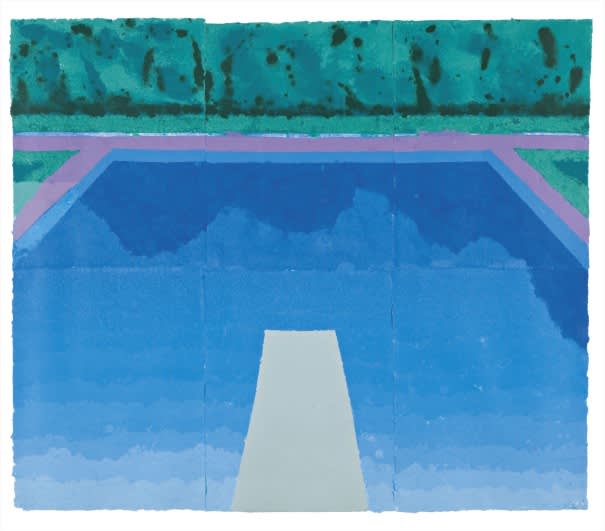
David Hockney
Autumn Pool (Paper Pool 29), 1978
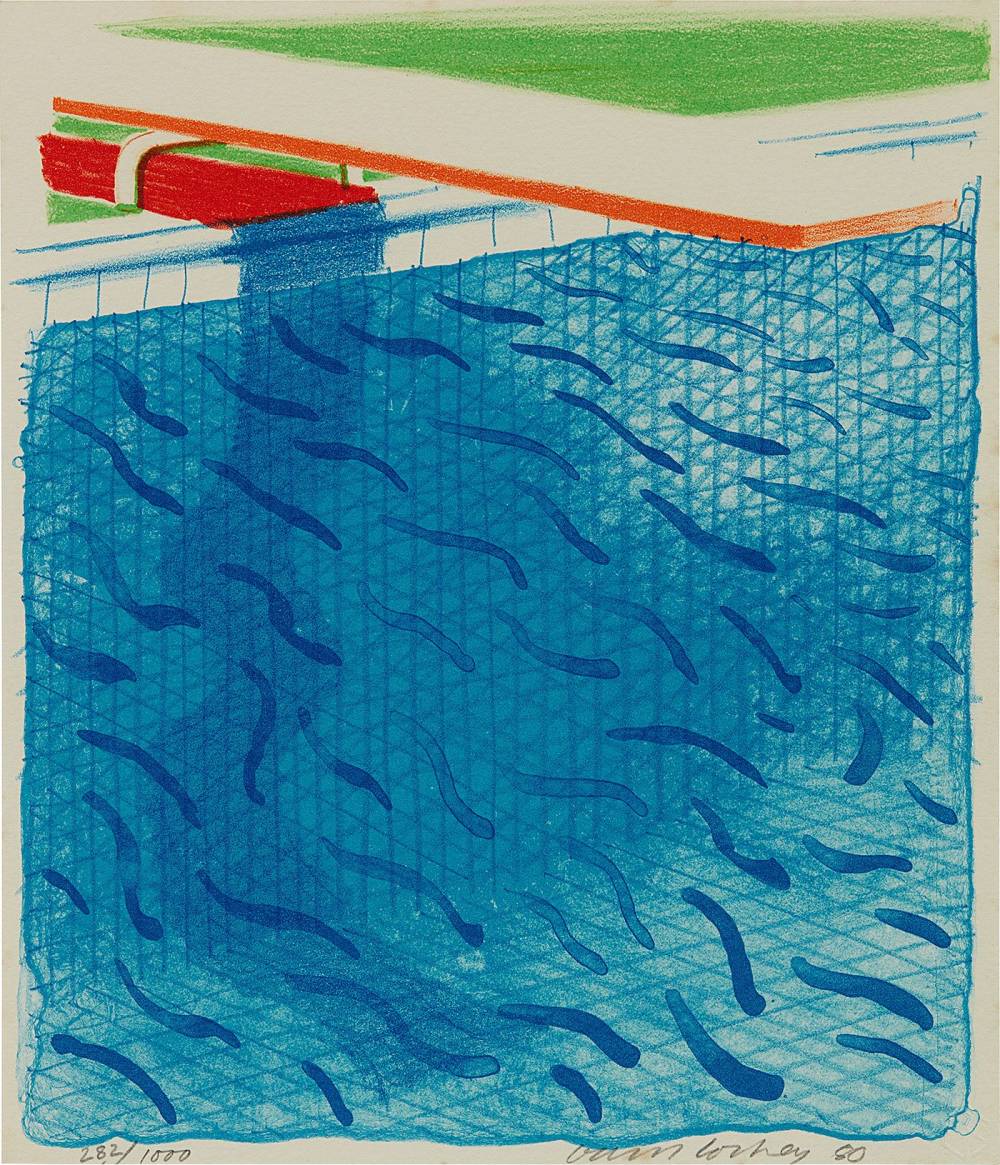
David Hockney
Pool Made with Paper and Blue Ink for Book, from Paper Pools, 1980

David Hockney
In the process of painting the Roosevelt Hotel swimming pool, Los Angeles
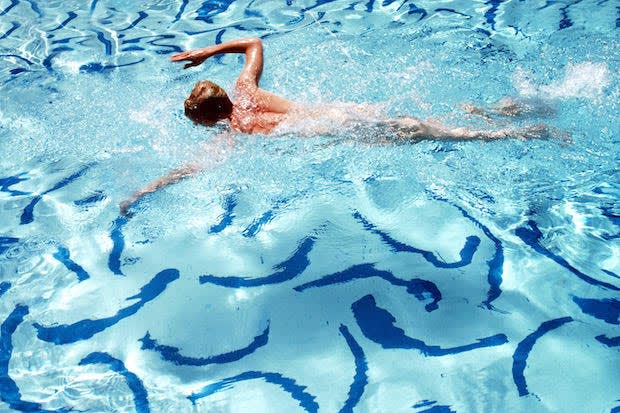
David Hockney
Swimmer in painted pool
Hockney was not the first artist to leave his mark on a swimming pool. In 1961, Pablo Picasso painted a swimmer and signed his name on the bottom of an outdoor swimming pool in Spain belonging to the artist’s close friend, Flamenco dancer Antonio El Bailarin. Keith Haring painted a mural on the walls of the Carmine Street public pool in New York, emphasizing his work with the community of New York. At the Colombe d’Or in France, a large Alexander Calder mobile sits on the edge of the pool, sent after Calder and other artists frequented the hotel. Swiss conceptual artist Sylvie Fleury painted inspiring phrases around the edges and bottom of the pool at gallery owner Thaddaeus Ropac’s Austrian estate, which also boasts a bronze bunny fountain made by Tom Sachs.
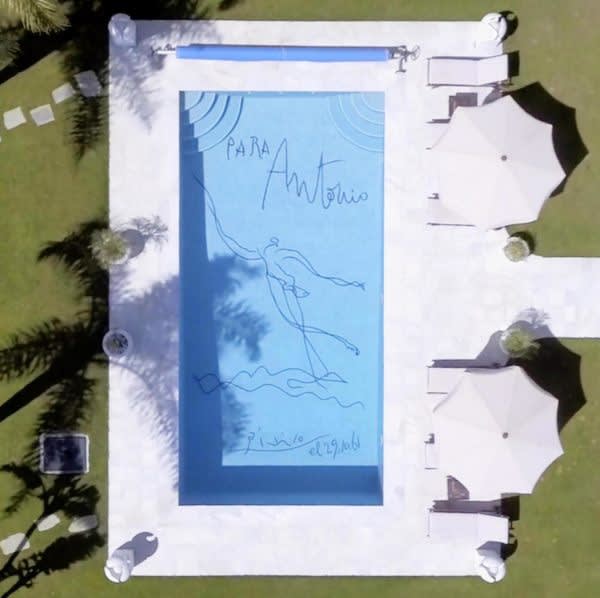
Pablo Picasso
Painting Antonio El Bailarin's Pool, 1961
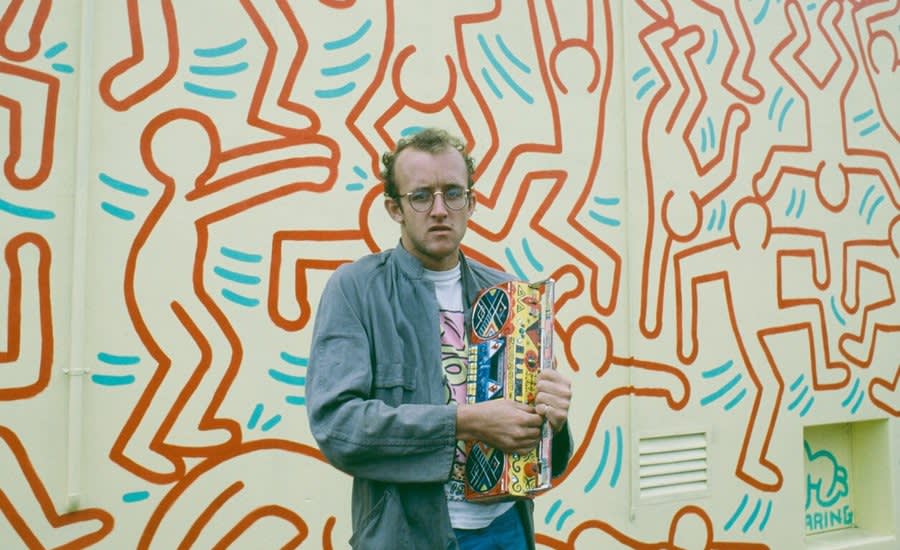
Keith Haring
Mural at Carmine Street Pool, NYC

Keith Haring
Mural at Carmine Street Pool, NYC
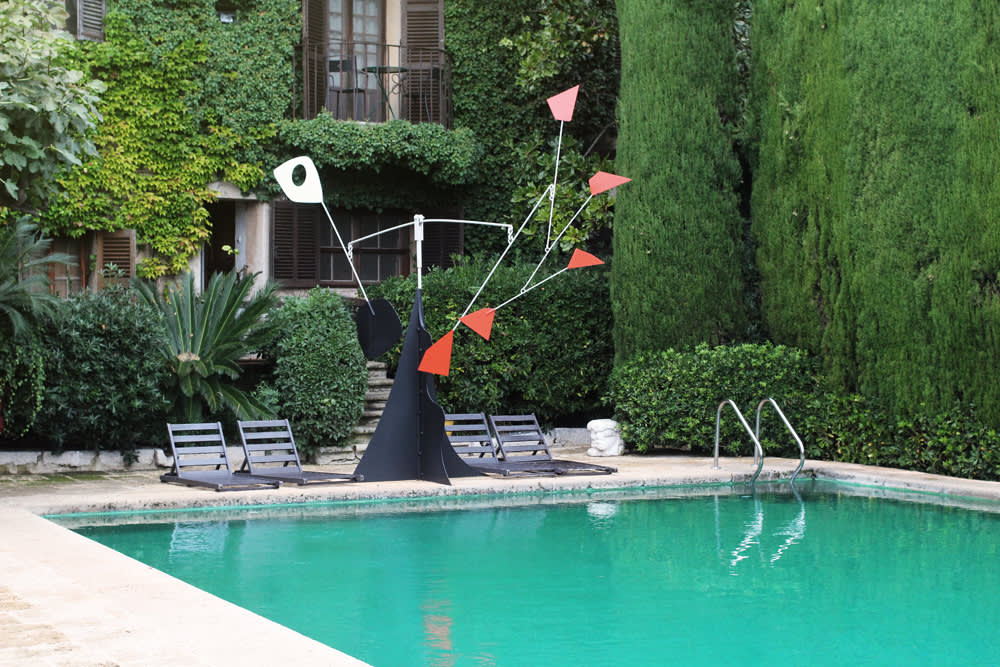
Alexander Calder
Mobile, At the Colombe d’Or, France

Alexander Calder
Mobile, At the Colombe d’Or, France
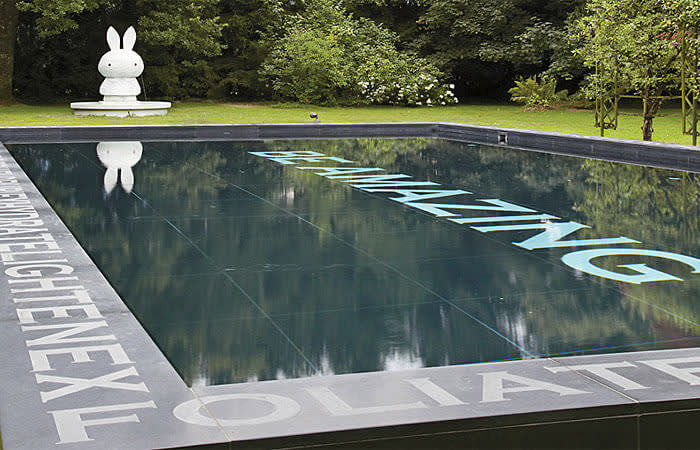
Sylvie Fleury
Painting in Thaddaeus Ropac’s Pool, Austria
Other artists utilize the shape and form of the swimming pool in their works. Installation artist Leandro Erlich constructed a full-size pool at MoMA P.S. 1. Using suspended water trapped in acrylic over the pool, Erlich’s installation gives the impression that visitors are walking underwater when in fact the pool was empty. Typical of Erlich’s works, the installation seems to defy the laws of physics. Artist duo Michael Elmgreen and Ingar Dragset created a sculpture entitled Van Gogh’s Ear in 2016. Taking the form of an upright swimming pool, the sculpture sits at New York’s Rockefeller Center as a symbol of the area where fashion, art, business, and commerce meet. The pool is in a retro “kidney” shape, typical of midcentury design. Within this crowded urban space, the suburban pool creates a surreal image. Similarly, artist Harold Ancart created a series of minimalist relief sculptures that resemble swimming pools, each consisting of a basin and staircase. Made of styrofoam, concrete, and paint, Ancart’s sculptures bring a piece of suburban life to New Yorkers, who rarely have a swimming pool. In 1952, Henri Matisse installed a cutout “swimming pool” around the walls of his dining room in Nice. Inspired by Matisse’s favorite pool in Cannes, the cutouts feature swimmers, divers, and sea life pinned to white paper. This piece became Matisse’s first and only cutout installation. Photographer Slim Aarons used the swimming pool as a background for many of his shots in the 1950s, 60s, and 70s. Aaron’s most famous photograph, a portrait of icon C.Z. Guest, was shot in front of her Palm Beach pool.
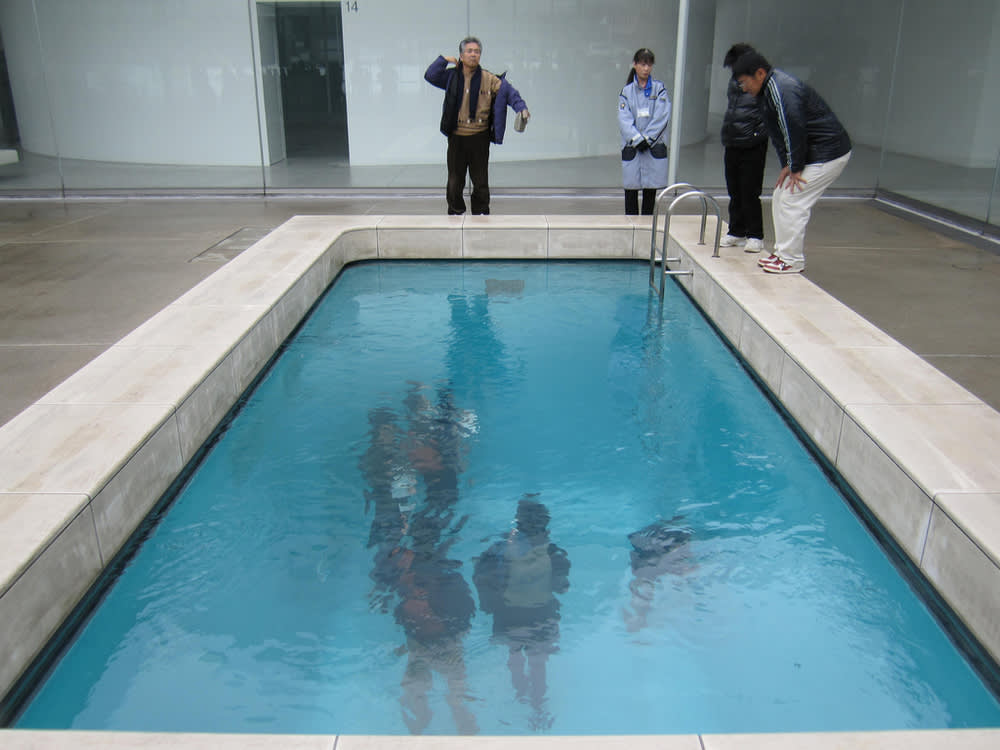
Leandro Erlich
Pool at MoMA P.S. 1
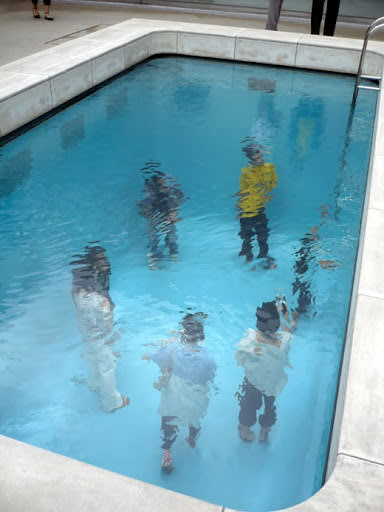
Leandro Erlich
Pool at MoMA P.S. 1

Michael Elmgreen and Ingar Dragset
Van Gogh’s Ear, 2016
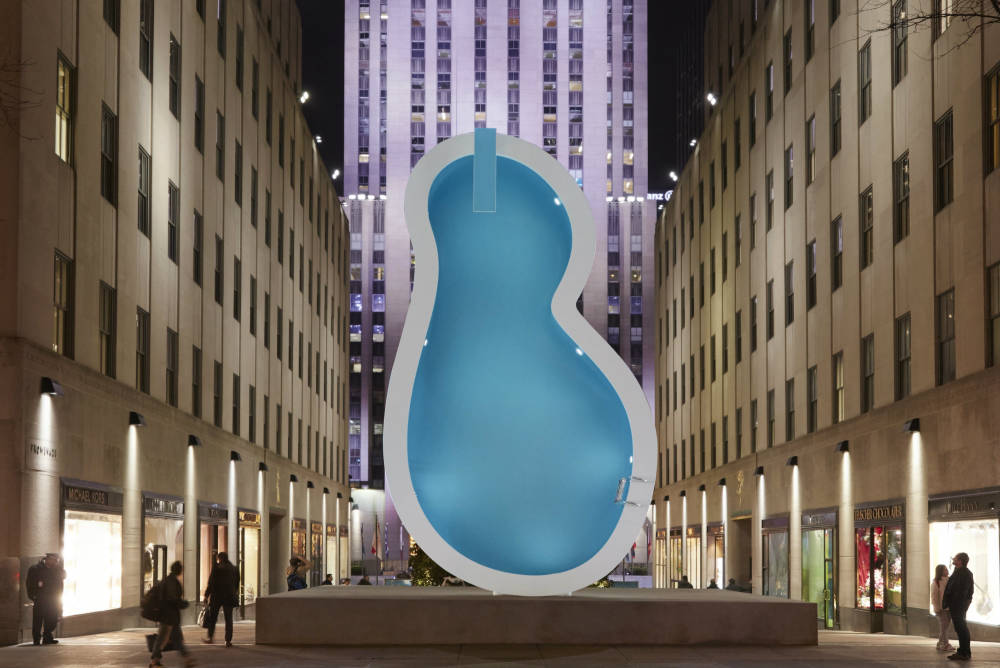
Michael Elmgreen and Ingar Dragset
Van Gogh’s Ear, 2016
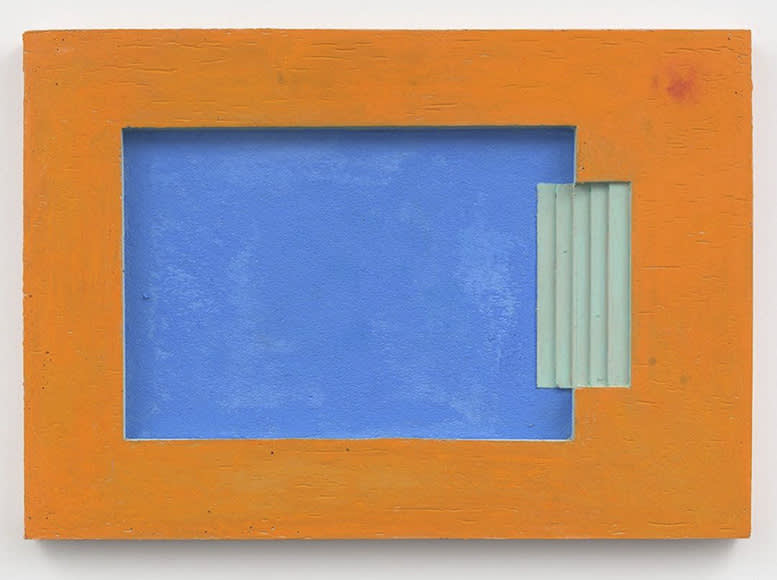
Harold Ancart
Swimming pools as three dimensional relief forms
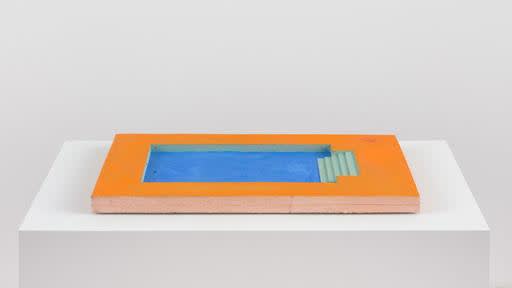
Harold Ancart
Swimming pools as three dimensional relief forms
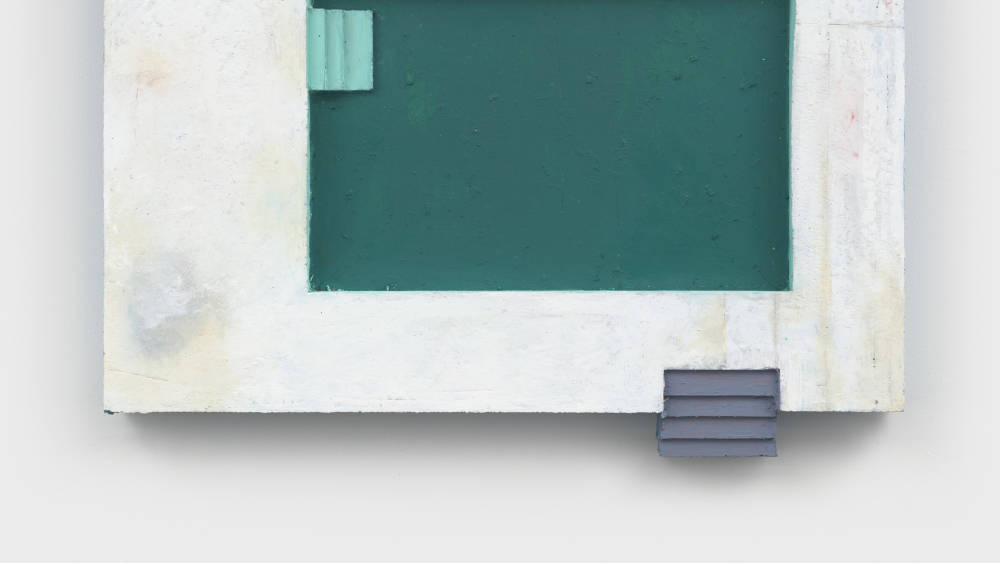
Harold Ancart
Swimming pools as three dimensional relief forms
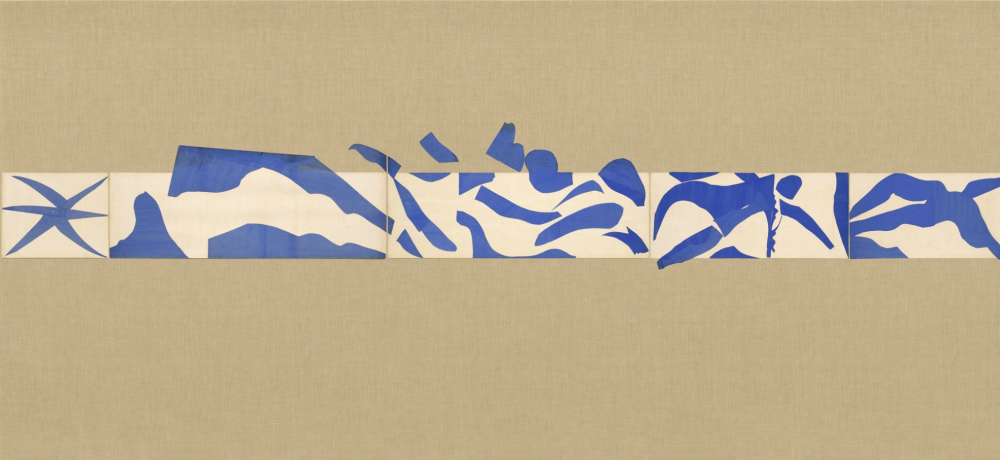
Henri Matisse
The Swimming Pool, late summer 1952
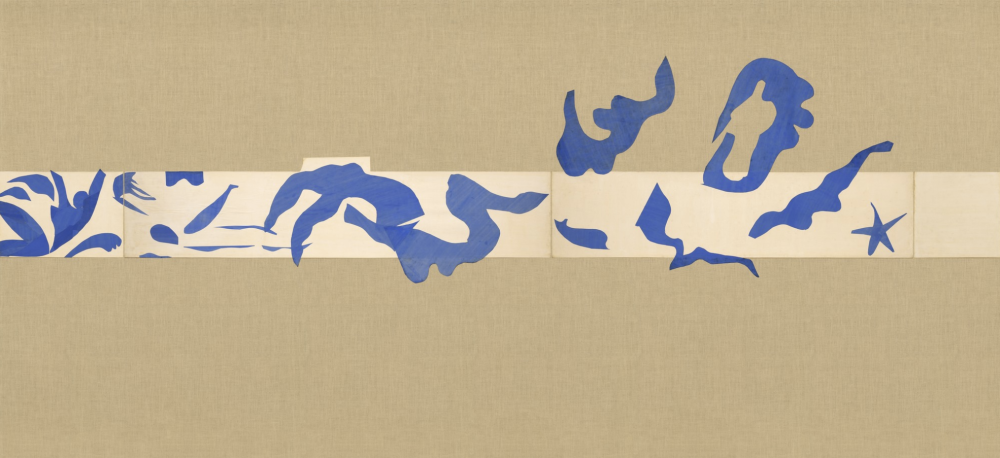
Henri Matisse
The Swimming Pool, late summer 1952
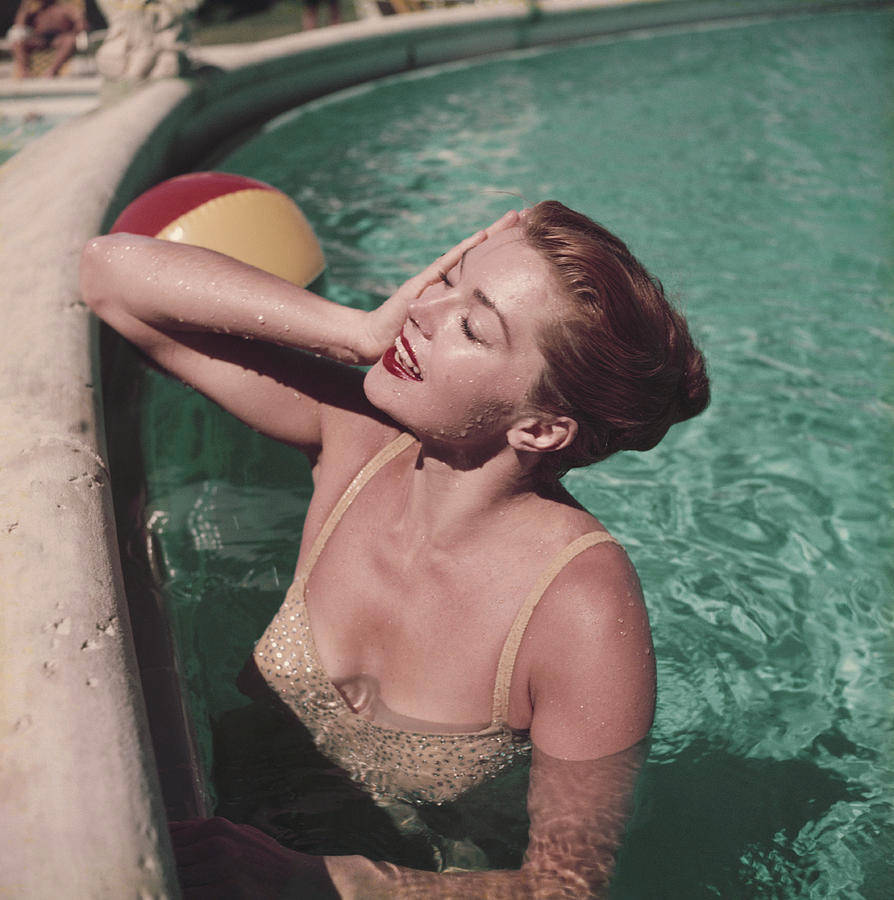
Slim Aarons
Esther Williams, 1950s
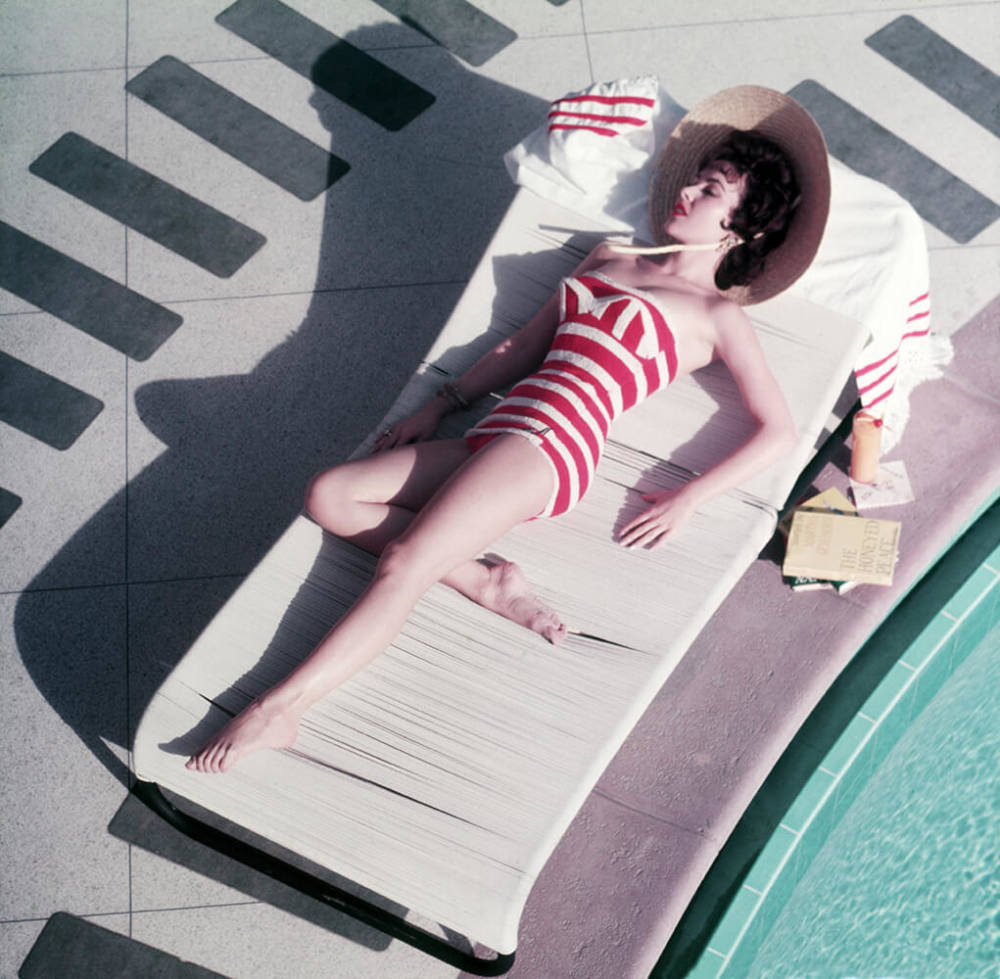
Slim Aarons
Pool Photograph, 1950s
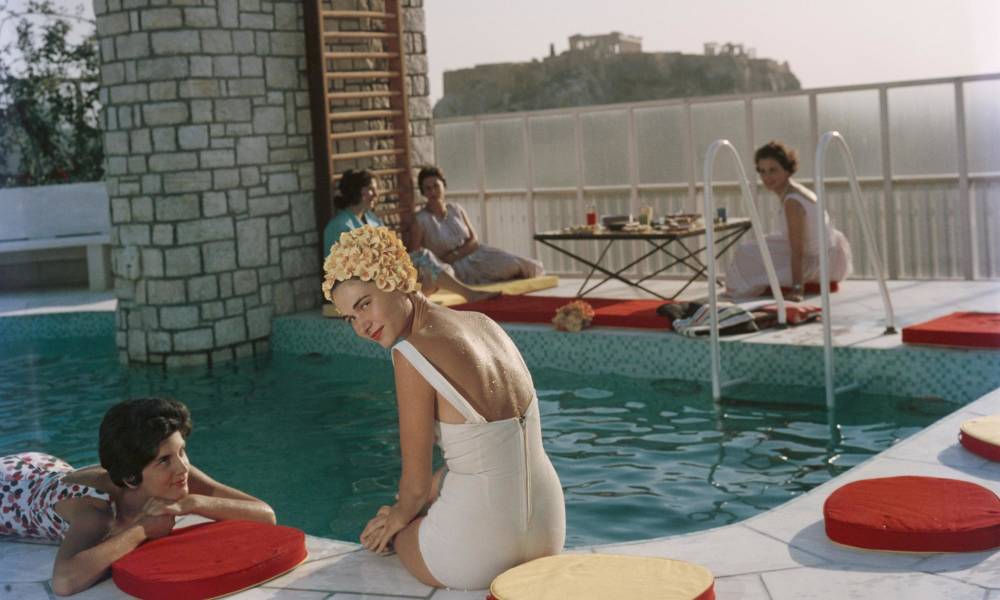
Slim Aarons
Pool Photograph, 1960s
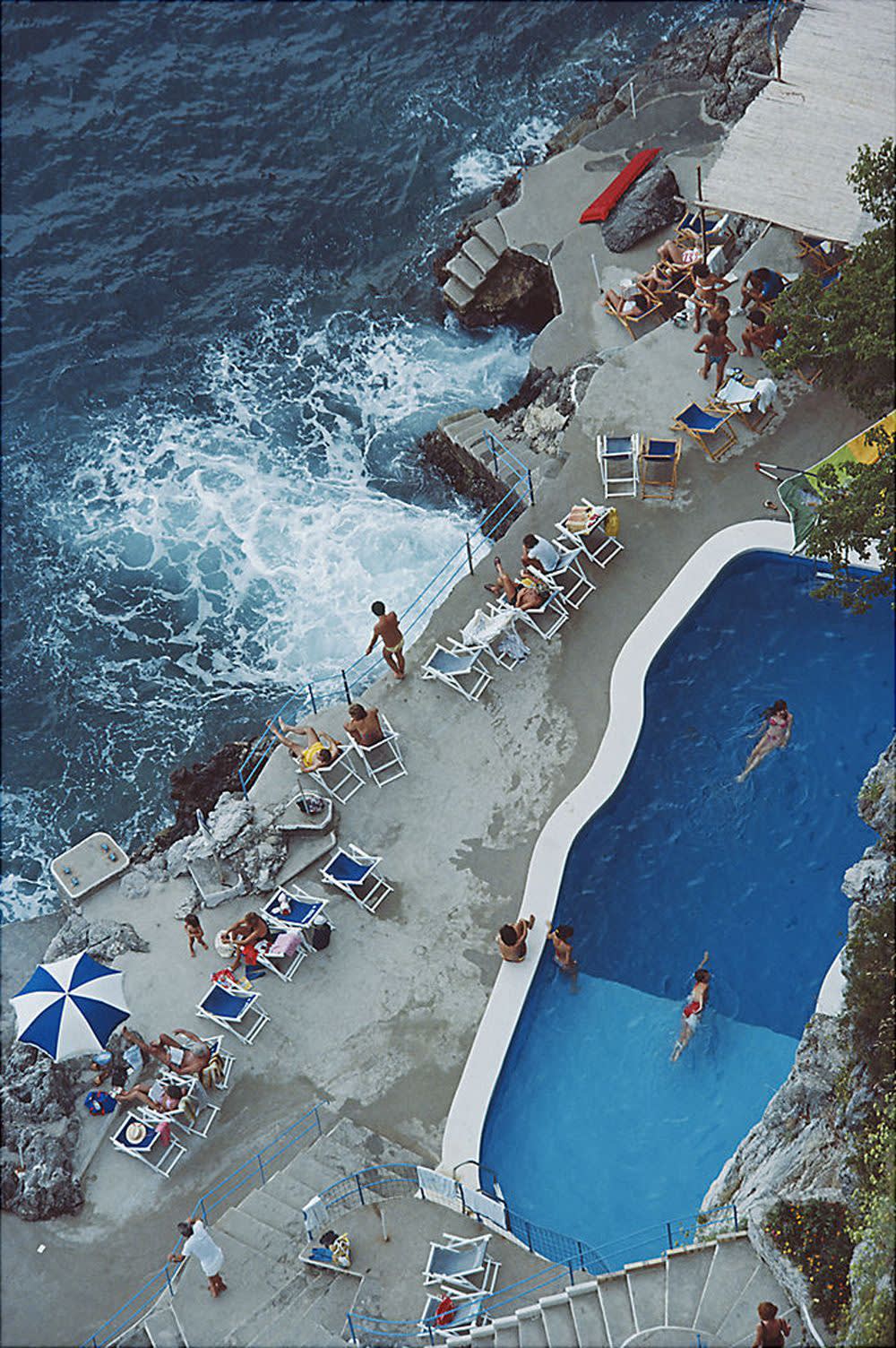
Slim Aarons
Arial Pool Photograph, 1970s
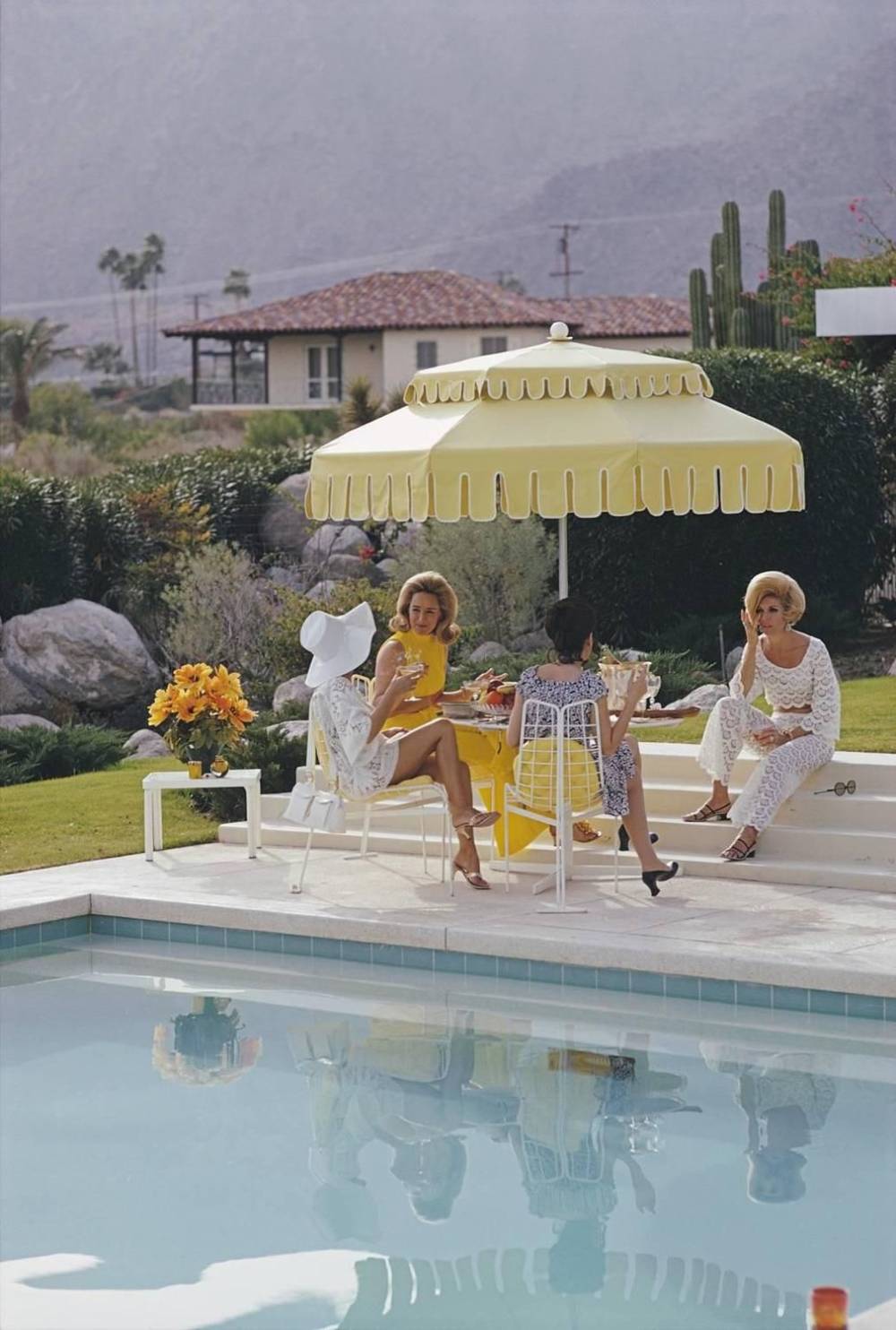
Slim Aarons
Pool Photograph, 1970s
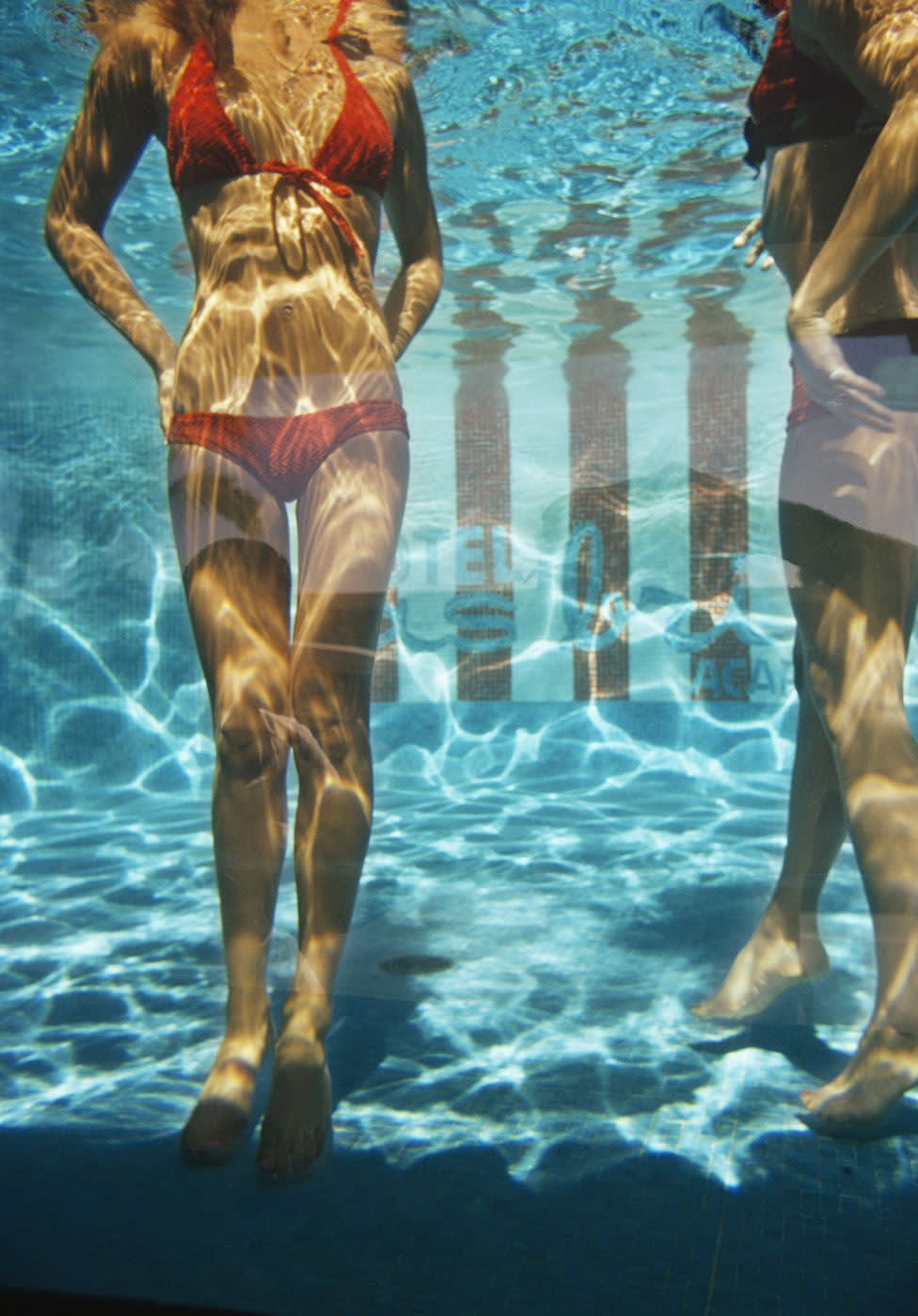
Slim Aarons
Pool Photograph, 1970s
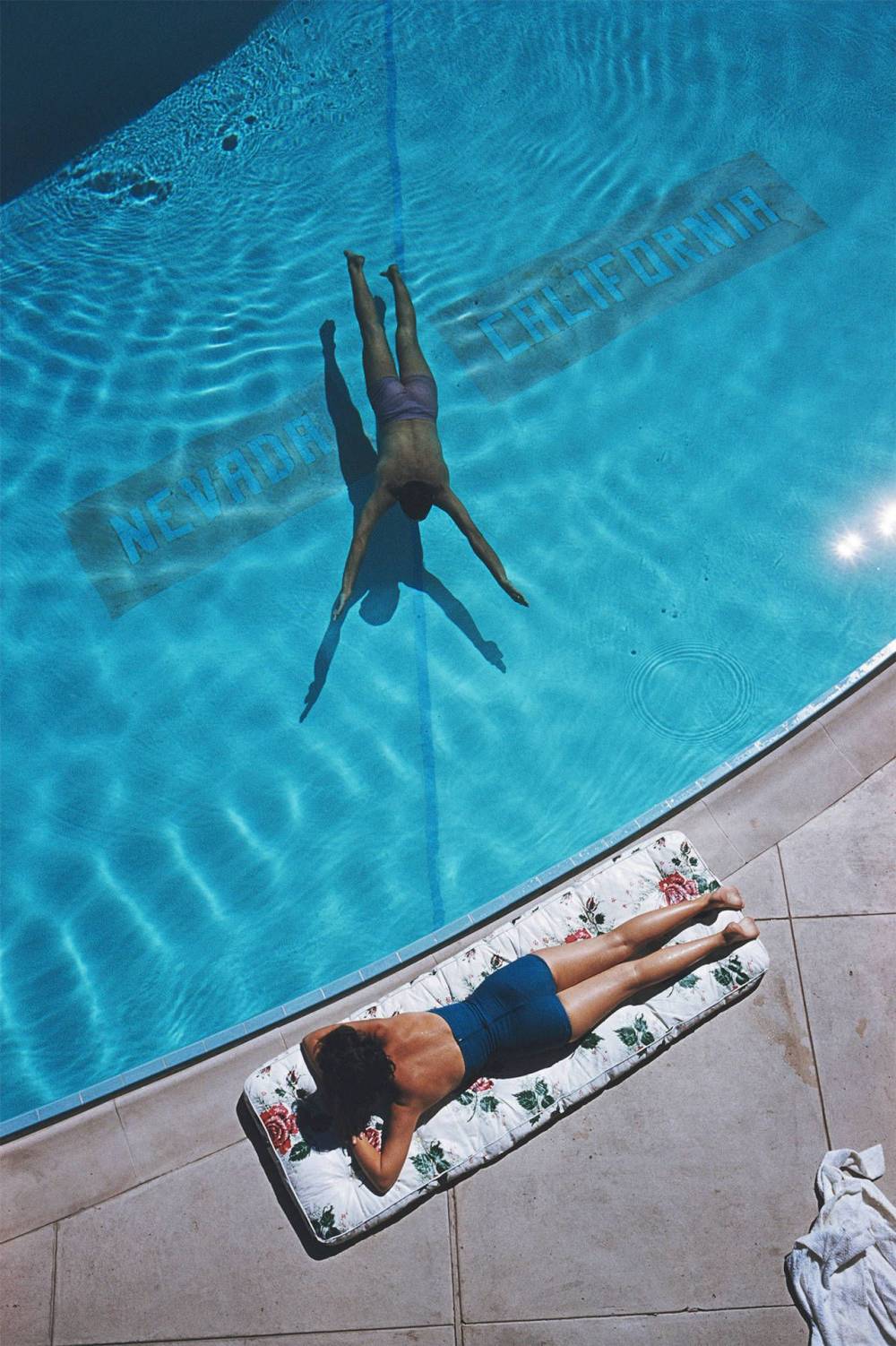
Slim Aarons
Pool Photograph, 1970s
Always changing with the seasons, the fashion world has developed, re-developed, and taken inspiration from swimwear and the idyllic summer setting of the swimming pool. Vogue’s June 1927 issue demonstrates the importance and popularity of ever-changing swimwear in the fashion world. The cover for this Summer travel issue features a geometric image of a woman in a pool, wearing a swim cap and holding a beach ball. This image immediately invokes summertime and emphasizes the focus on swimwear. Historic designers have been re-inventing swimwear for decades. In 1944, Claire McCardell created the playsuit. An origin of the modern-day romper, McCardell’s creation was made of cotton instead of wool fabric, making it easier to swim in and more comfortable when wet, and also allowing the form of the garment to puff and ruffle. The playsuit’s halter style and open back add a youthful playfulness to the piece, emphasizing freedom rather than sexuality. In 1946, McCardell came out with a response to the French bikini: a two-piece suit consisting of a halter top and wrap skirt. Made in gray wool, the piece adds volume at the bust and waist to disguise sexuality and adhere to America’s more modest style. From the 1940s through the 1970s, Tom Brigance became a prominent name in American swimwear and leisure design. Brigance gained fame in 1939 when, working as a designer for Lord & Taylor, the Duchess of Windsor bought six of his outfits. Brigance’s design for the skirted swimsuit became a best-seller, and the design remains prominent in the market today.
Claire McCardell
Playsuit, 1944
Claire McCardell
Playsuit, 1944
Tom Brigance
Bathing Suit, 1940s
Tom Brigance
Bathing Suit, 1940s
Tom Brigance
Bathing Suit, 1940s
Tom Brigance
Bathing Suit, 1940s
Pushing the idea of swimwear further than ever before, Austrian designer and fashion prophet Rudi Gernreich’s 1964 Monokini design made waves in American fashion, despite rarely being recorded or worn. The design—a topless women’s swimsuit—seeks to desexualize rather than emphasize the breasts. The high-waisted garment provides ample coverage on the bottom and is held up with two straps. Having fled the Nazis with his mother, Gernreich made the Monokini as a response to Hitler’s ban on nudity, making it a heavily political design. Many fashion magazines refused to publish images of the Monokini, and the design was even banned in the Soviet Union as a representation of American decadence. One of the most inarguably iconic swimsuit images, Farah Fawcett’s 1976 red one-piece, shot by Bruce McBoom, became a representation of freedom in the 1970s. Norma Kamali, who designed Fawcett’s swimsuit, didn’t like the design and said the piece was unfinished. The beach photoshoot was impromptu, and Fawcett happened to have the swimsuit in her bag. The swimsuit’s influence is still ever-present in pop culture today.
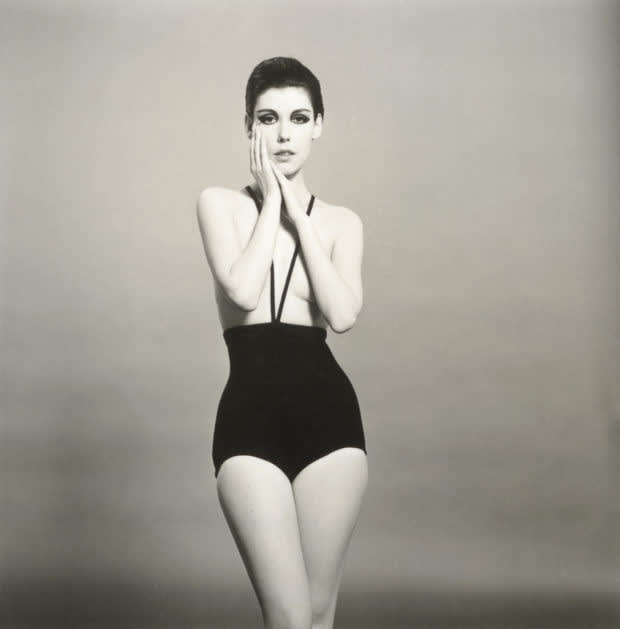
Rudi Gernreich
Monokini, 1964
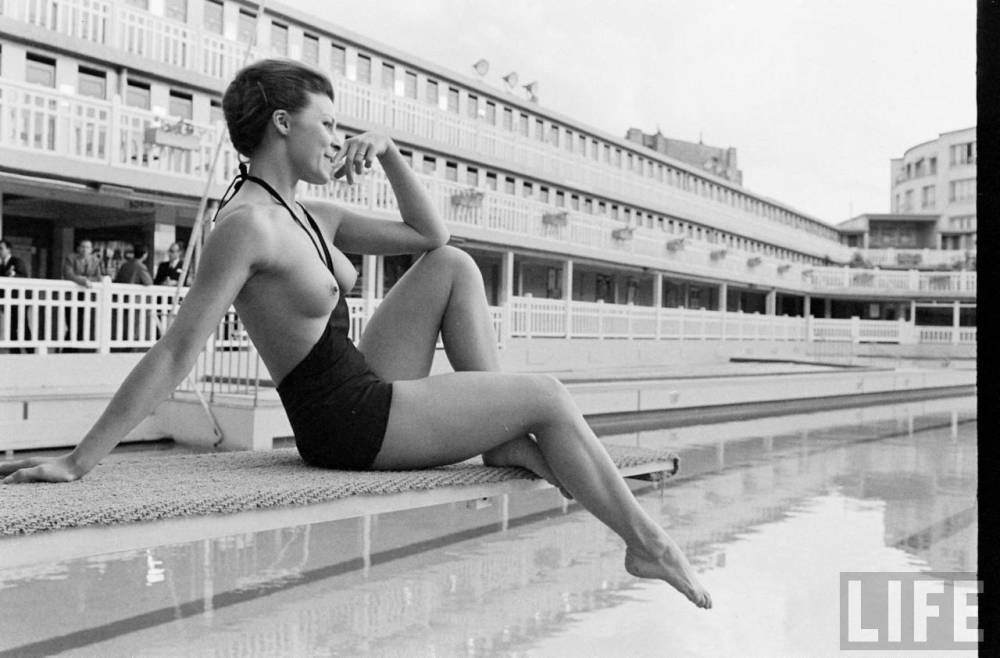
Rudi Gernreich
Monokini, 1964
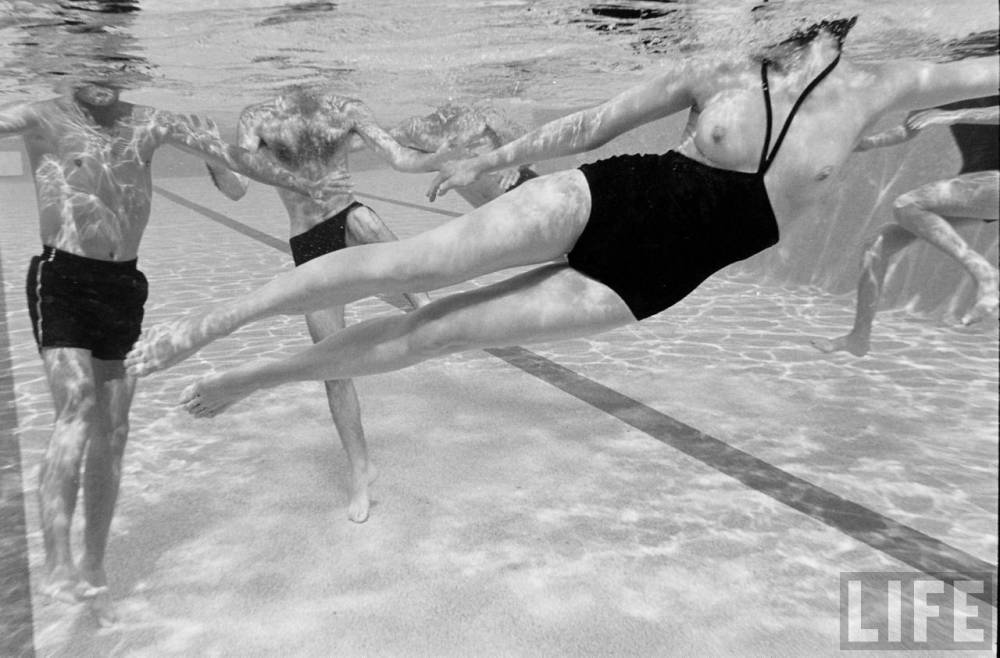
Rudi Gernreich
Monokini, 1964
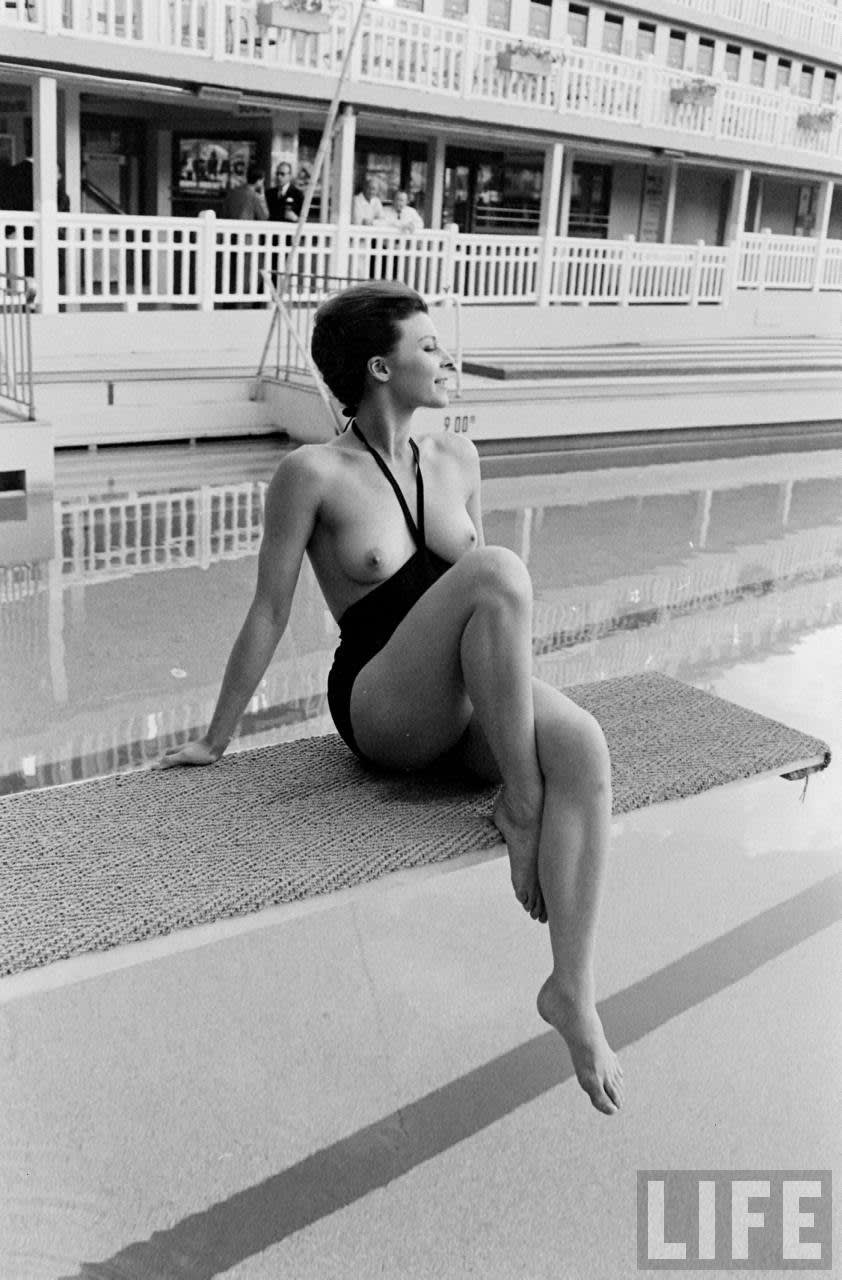
Rudi Gernreich
Monokini, 1964
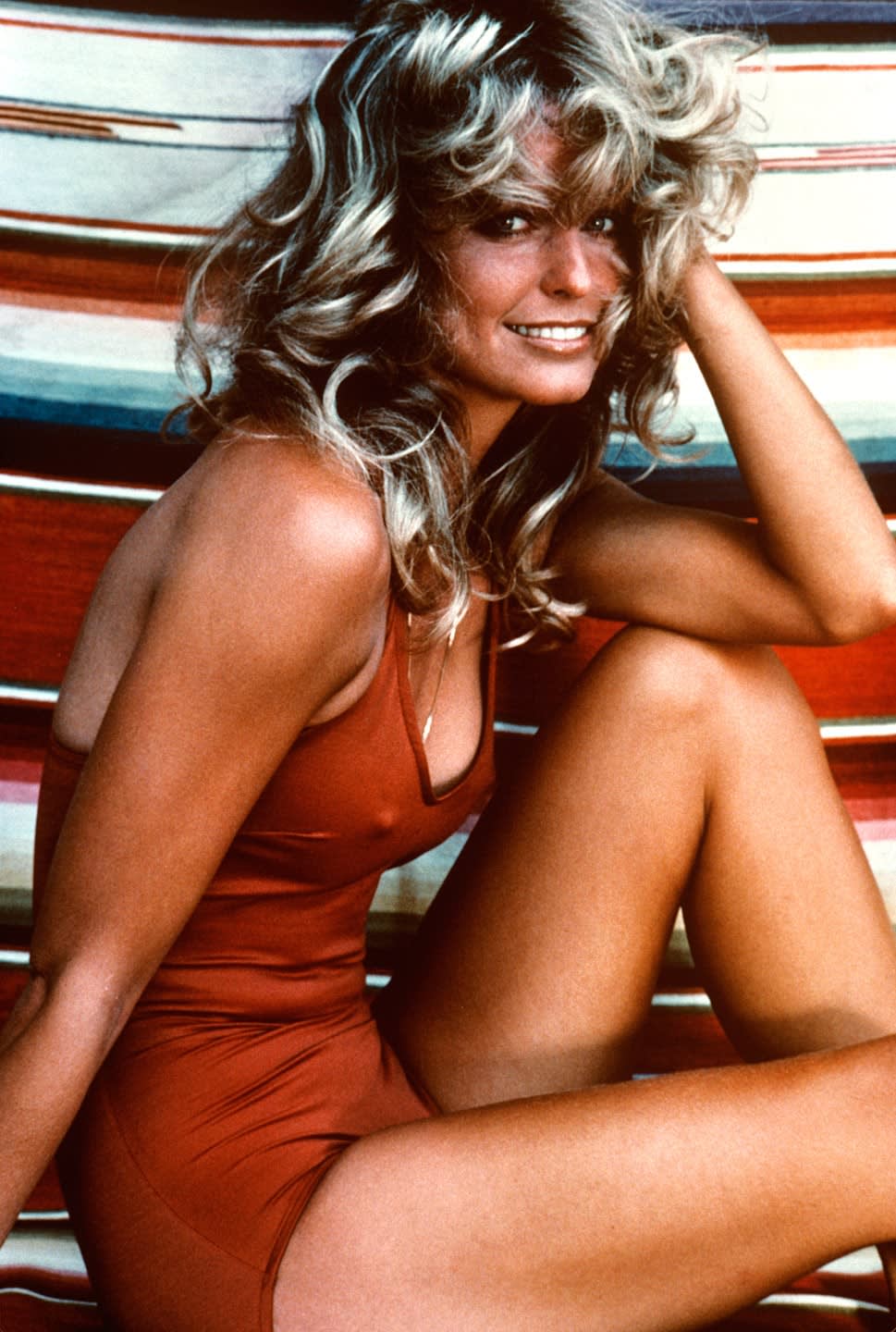
Norma Kamali
Farah Fawcett’s red one-piece, shot by Bruce McBoom, 1976
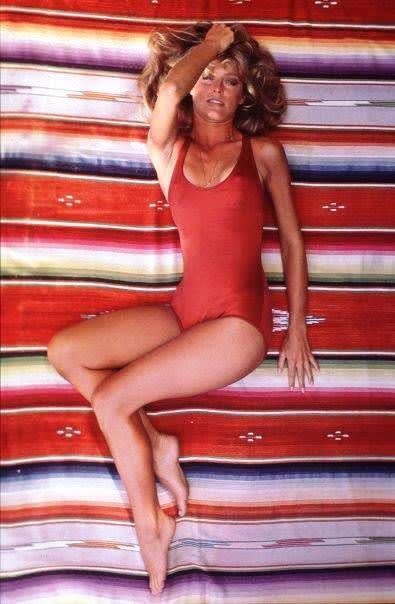
Norma Kamali
Farah Fawcett’s red one-piece, shot by Bruce McBoom, 1976
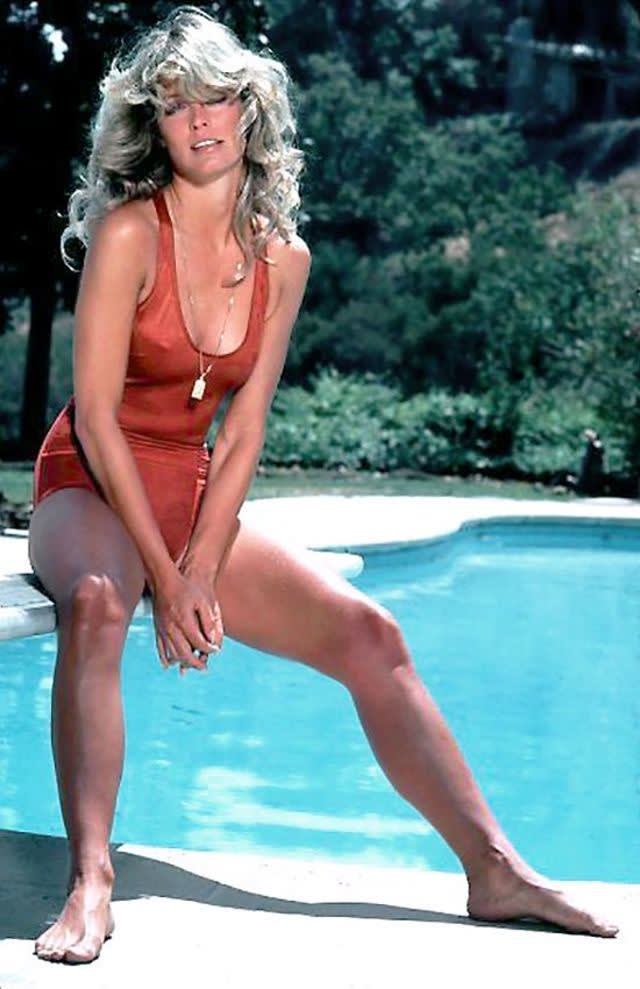
Norma Kamali
Farah Fawcett’s red one-piece, shot by Bruce McBoom, 1976
In recent years, designers have taken to incorporating elements of swimwear into everyday outfits. Thom Browne’s Spring/Summer 2017 collection exemplifies this: models in trompe l’oeil dresses and chic printed swim caps unzipped them from behind like wetsuits, revealing coordinated red, blue, and white swimsuits. The show was set against a backdrop of pool tiles that invoked the perfect environment for swimsuit wearing. Karl Lagerfeld, ever the master-of-all-trades, leant his design expertise to the Hotel Metropole in Monte-Carlo. Lagerfeld designed a series of constellation lights across the pool floor, along with a mural inspired by The Iliad and The Odyssey.
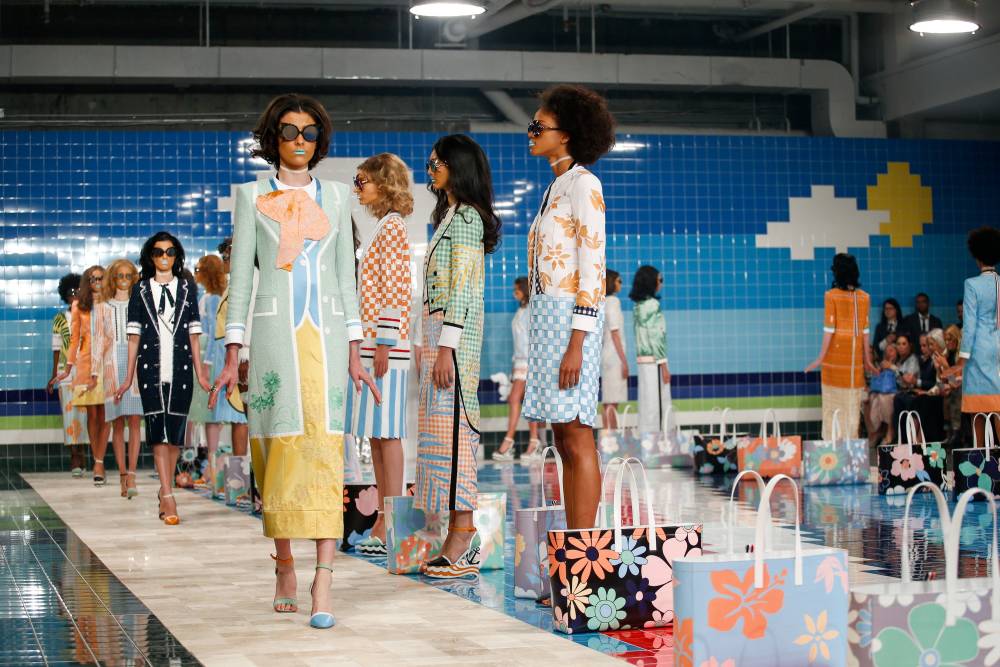
Thom Browne
Spring/Summer 2017
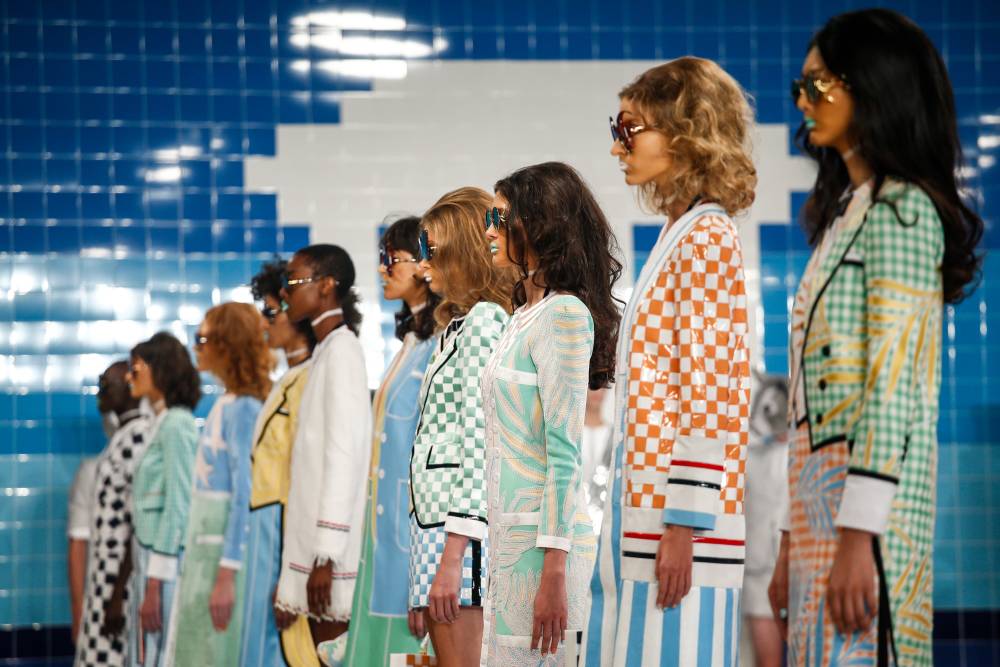
Thom Browne
Spring/Summer 2017
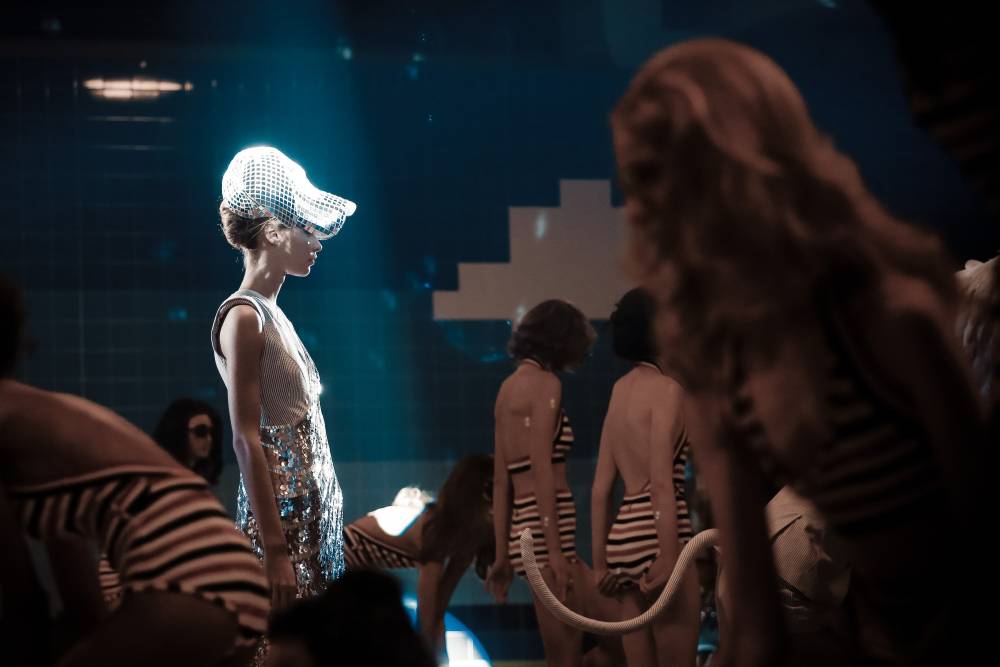
Thom Browne
Spring/Summer 2017

Thom Browne
Spring/Summer 2017
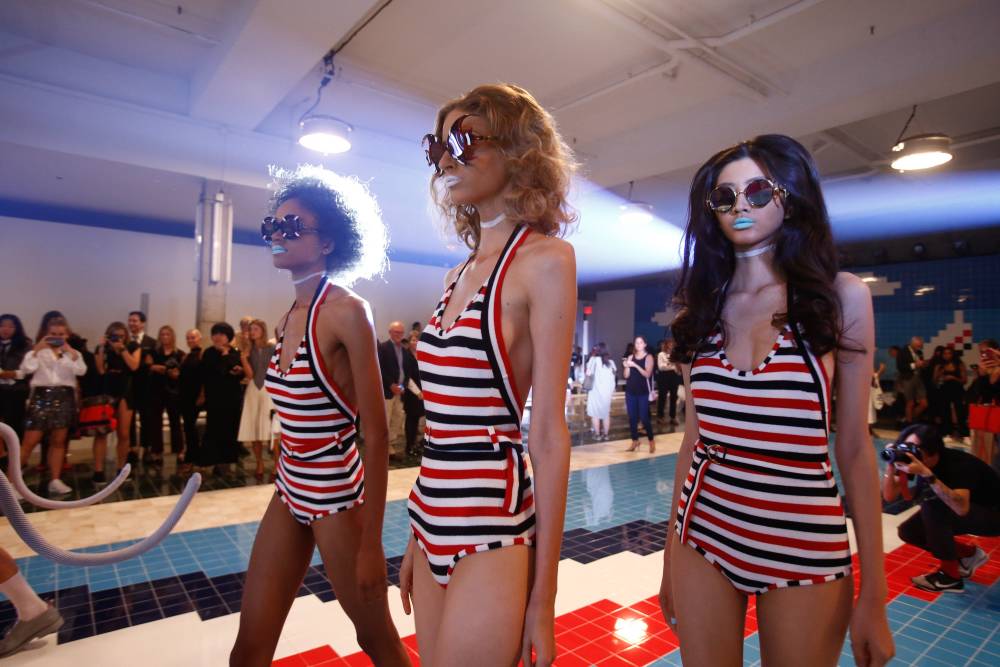
Thom Browne
Spring/Summer 2017
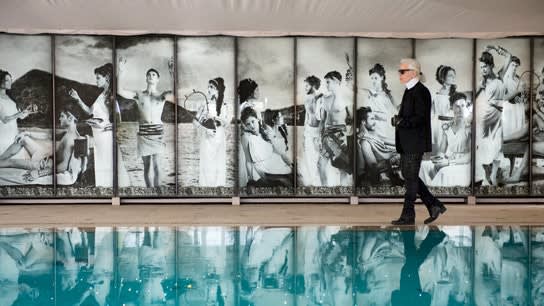
Karl Lagerfeld
Poolside mural he created for Monaco's Hôtel Métropole Monte-Carlo
Pool design ranges widely from faux-natural to Grecian-inspired to Midcentury Modern. The design of a pool can evoke anything from a Roman bathhouse to a microscopic organism, depending on the designer’s intention. The kidney-shaped pool, which grew popular in the American suburbs during the 1950s, was actually created by Finnish architect Alvar Aalto. In 1939, Aalto finished his Villa Mairea in Finland which explored modernist architecture and organic forms including a biomorphic kidney-shaped pool with all-curved edges, even at the bottom. In 1948, Thomas Church, a friend of Aalto’s, designed the Donnell House in California. Inspired by Aalto’s natural forms, Church implemented the kidney pool design into the landscape. Widely published across the U.S., the kidney pool became a mainstay of midcentury modern design. On the opposite end of the spectrum, Hearst Castle boasts two Roman- and Grecian-inspired pools. Built for publisher William Randolph Hearst and family, the castle includes an indoor and outdoor pool. The Neptune outdoor pool, which is 104 feet long, features tiled flooring, a Grecian temple, and a marble statue of Neptune. The indoor Roman Pool, which was built to mimic a Roman bathhouse, features 8 statues of Roman gods and goddesses as well as mosaic tiles in the 5th century Italian style. The extravagant pools have been featured across popular culture, most recently used as the backdrop for Lady Gaga’s GUY music video.

Alvar Aalto
Villa Mairea in Finland, 1939

Alvar Aalto
Villa Mairea in Finland, 1939
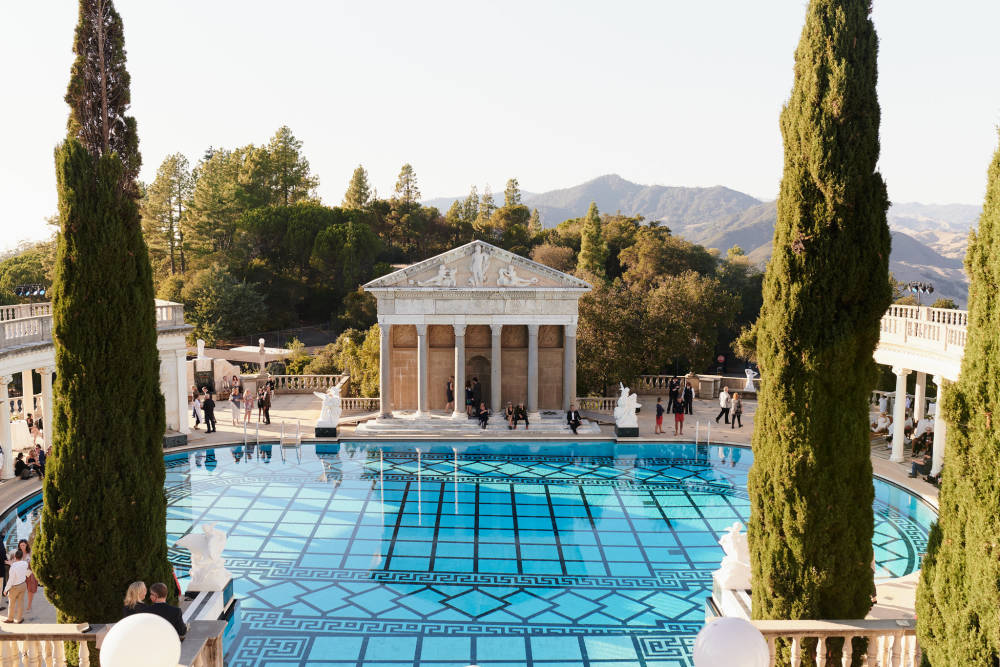
Roman and Grecian inspired pools
Built for publisher William Randolph Hearst
Architects have frequently utilized the swimming pool as a key feature in their design for hotels and apartment buildings. Paris’s Shangri-La hotel, which draws influence from East Asia, lets a 16-metre mosaic pool take center stage, unimpeded by a crisp white backdrop. Budapest’s Gellert Baths, on the other hand, allow the pool and building to work in tandem to create an exquisite visual experience. Built in 1918 in the Art Nouveau style, the 2,650 square foot thermal pool is emphasized by a long gallery and glass roof.
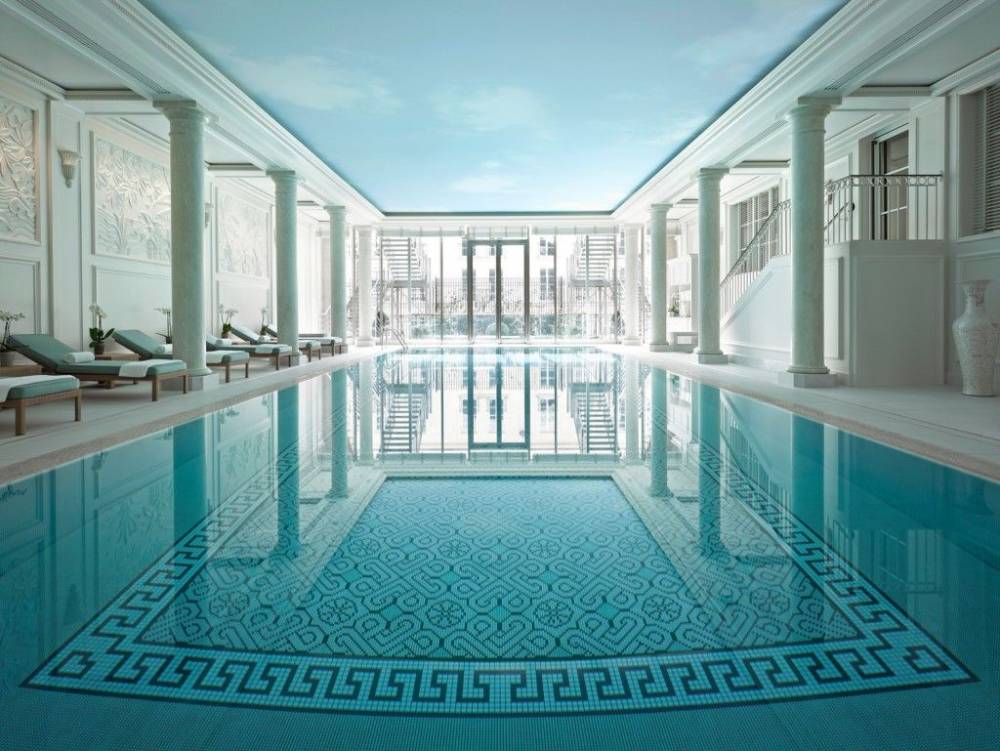
Shangri-La Hotel
Pool, Paris, France
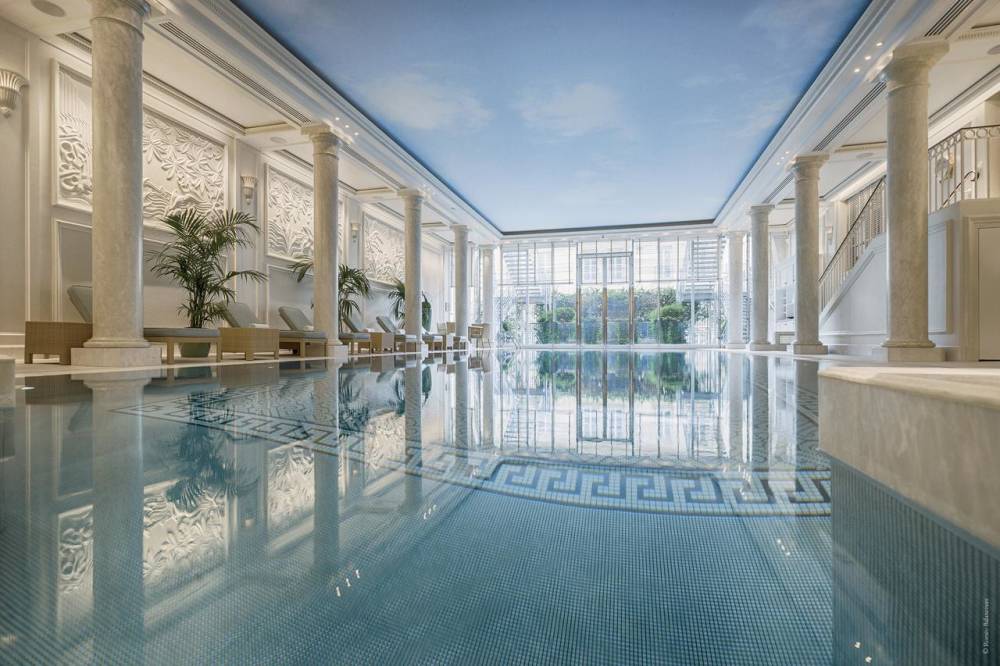
Shangri-La Hotel
Pool, Paris, France
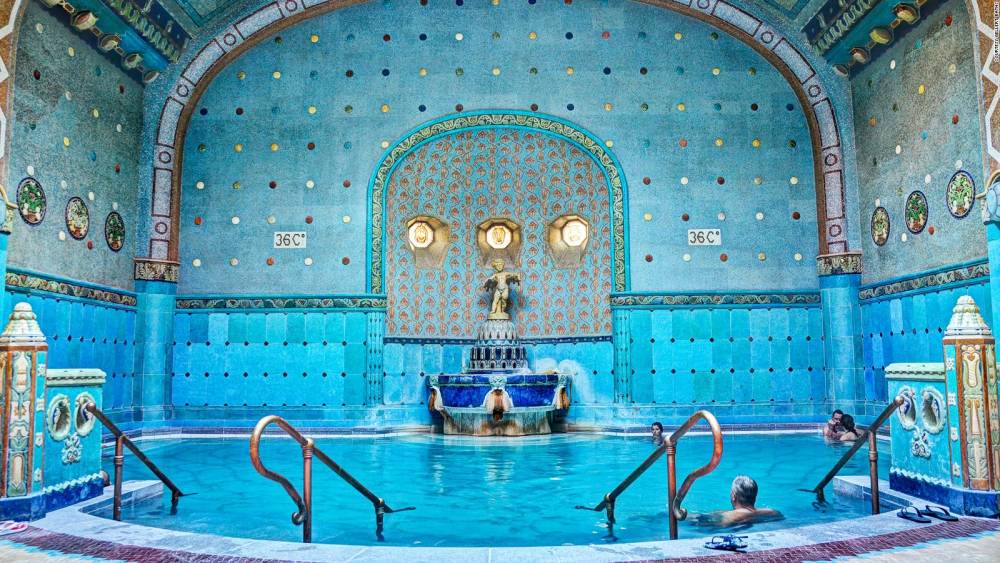
Budapest’s Gellert Baths
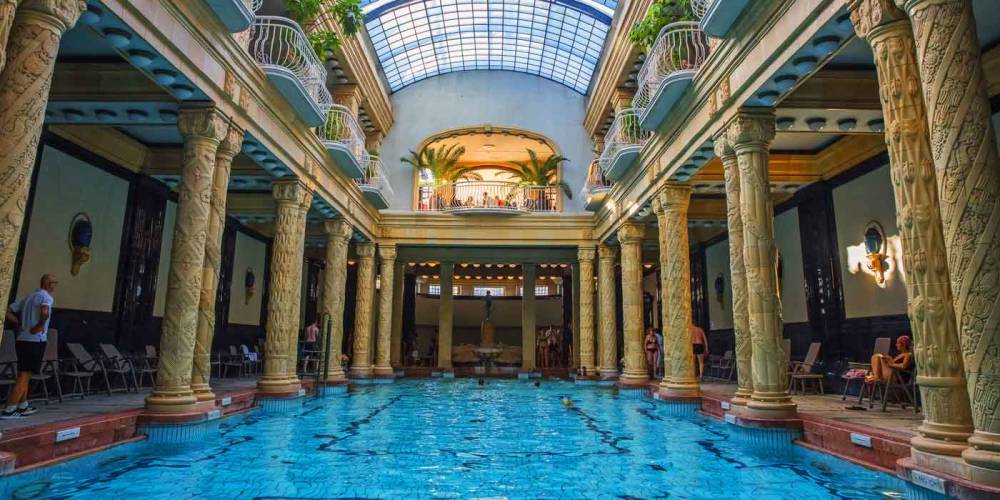
Budapest’s Gellert Baths
While some pools look to the past for inspiration, others experiment with modern architecture in new and unique ways. In London, HAL architects designed a glass “sky pool” which is suspended mid-air between two apartment complexes. Acting as a “human aquarium,” the pool provides fantastic views of London while also forming the entrance to the complex as a sort of entablature. Canada’s Maurice Martel Pool House is a tribute to modernism, inspired by Phillip Johnson’s Glass House and the Ben Rose House featured in the film Ferris Bueller’s Day Off. The interior is composed of a large swimming pool, a lounge area, and a bathroom which are all visible from the outside. A metal structure gives the roof an appearance of “floating” above the glass walls, incorporating conceptual themes of the swimming pool into the heart of the design. Midcentury architect Richard Neutra experimented with a variety of different shapes and materials for the swimming pool, especially in the Palm Springs area. Neutra’s Wirin House, built in 1949, features a sleek modern pool, while the Oyler House features a more natural design: a rock pool. Made of a natural outcropping of rocks on the property, Neutra and Oyler used drills and explosives to create a basin. The result was a one-of-a-kind creation that incorporated the house’s desert landscape into its design.

HAL Architects
Sky Pool
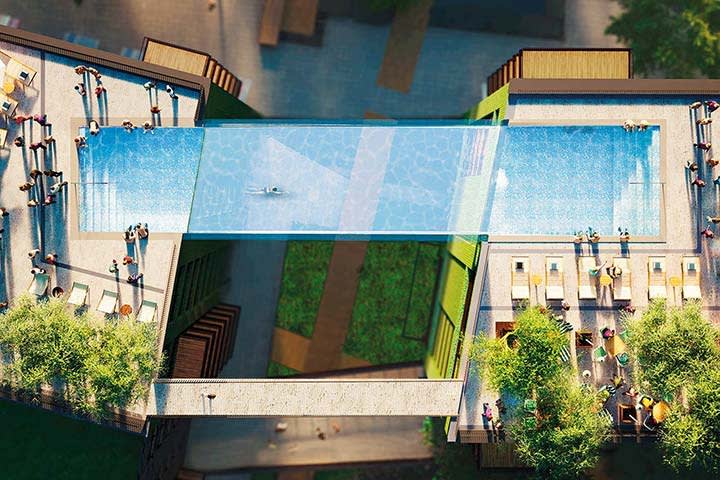
HAL Architects
Sky Pool

Maurice Martel
Pool House, Inspired by Phillip Johnson Glass House
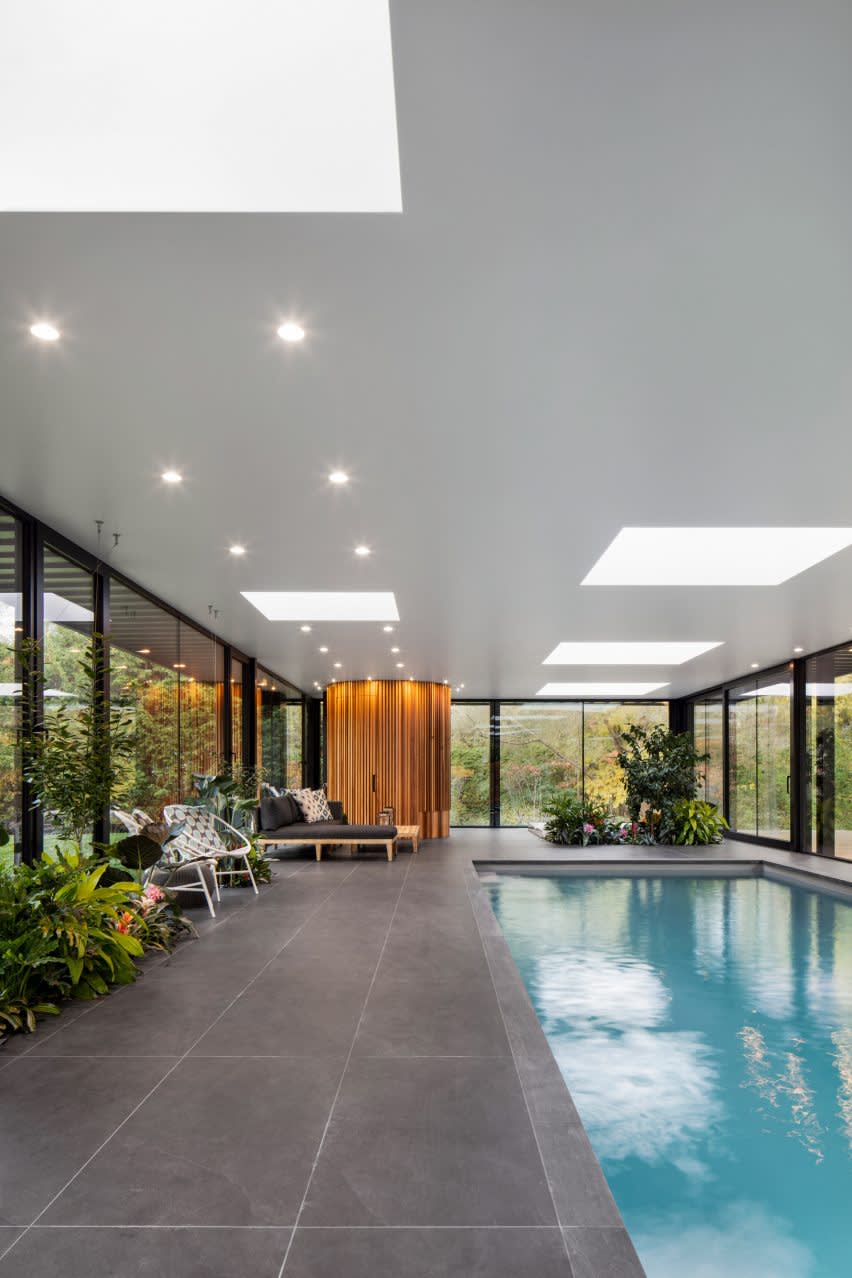
Maurice Martel
Pool House, Inspired by Phillip Johnson Glass House
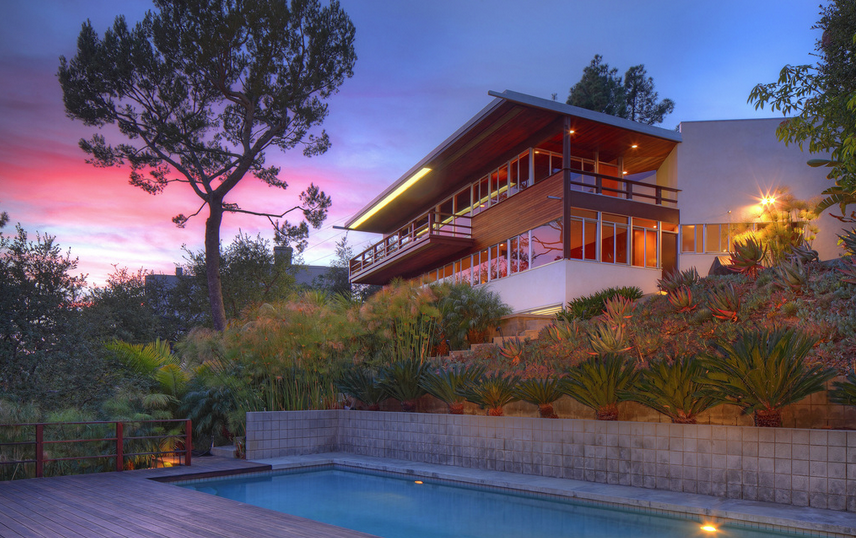
Richard Neutra
Wirin House, 1949
The swimming pool, above all, represents prosperity and freedom. Artists, designers, and architects alike have all put their unique spin on this summertime classic, imbuing it with art, history, and meaning, but the elegant weightlessness of the swimming pool will always carry with it a joyous feeling of freedom.
